1872-September 1885 Alf Sadler senior
Alf Sadler senior, grandson of Isaac Sadler who won the 1833 Epsom Derby with Dangerous, began his training career in Rottingdean, training horses for Lord St Vincent and Mr W Bevill. Alf had 4 sons and a daughter, Gladys, who married jockey and trainer Joe Cannon. His sons all forged a career in racing, training horses. Harry Sadler was at Heath House, but died in 1924, while Gordon was at Falmouth Lodge, but it was Alf Junior who had the longest training career. Unfortunately, Alf junior was holidaying in India as the guest of HH Maharajah Jam Sahib of Nawanagar, at the time of his father's funeral in January 1929. Alf senior moved to Stockbridge House in 1872, where one of his best early horses was Henry George, later renamed Reputation. His principal patrons whilst at Stockbridge House were Lord Hastings, Lord Cholmondeley, Honourable F Lambton and Hon George Lambton. Indeed, it was a horse trained by Alf Sadler which provided George Lambton with his first ride in the Grand National in 1885 on Lioness. Another notable future racing character to be guided by Alf Sadler was Fred Rickaby who started his apprenticeship with Alf at Stockbridge House. In October 1885 Alf moved to Primrose House Stables to train for Lord Durham, who had taken a lease on those stables from owner Lord Rosebery. He then moved to Graham Place where he trained in the years around the turn of the century, returning to Stockbridge House to resume training until his retirement in 1923. In early 1929 the funeral of Alfred Brettle Sadler took place in Newmarket. He had died on Thursday 24th January at Stockbridge House aged 82.
1878 Railway Stakes at Epsom SALTIER 10/1 owned by Mr S Western, trained by Alf Sadler and ridden by Tom Cannon
For over 4 centuries racing has been staged in Newmarket, but how have the racecourses evolved from an initial starting point at Fleam Dyke Pumping Station, some 8 miles from the town, with a winning post barely 200 metres from the town centre, into two world recognized, excellent racecourses and a universal acceptance that Newmarket is the Headquarters of racing?
To access an interactive racecourse map showing over 50 individually named racecourses CLICK HERE. The map will enable you to:-
1. Determine when extended races over 8 miles, 6 miles and 4 miles began to be replaced by the courses now visited by thousands annually;
2. Consider how the challenge of crossing the Devil's Dyke was overcome;
3. Contemplate why the town no longer has a steeplechase course despite having at least 5 courses during the past 2 centuries;
4. Examine the practicalities of having up to 48 starting posts and winning posts;
5. Appreciate that it was not financially viable to have an open racecourse spread widely across the heath, with a finishing post barely 200 metres from the town centre;
6. Research how and why the Cambridgeshire Handicap has been contested over 3 different courses.
NOTE: The map does not make mention of 2 particular courses:-
(i) Sefton Course (also known as the Cambridge Road Course)
Source: 1970 Raceform. Used from 1959 to 1975.
(ii) New Circular Course
The Circular Handicap was run on Friday 29th October 1875 on the New Circular Course of about two miles.
Source: London Standard (30th October 1875): ''the horses started near the Turn of the Lands, ran back way of the Cambridgeshire Course towards the Ditch, and afterwards proceeded down the side of the Tan Gallop, and turned into the Rowley Mile near the Bretby Stakes starting post, finishing at the stand at the end of the flat. Except in the hollow near the Cambridgeshire start the runners should have been visible all the way if the sky had been bright and clear''.
Another report hoped that the Circular Handicap would become a feature in future programmes, as it would be contested in front of the new grandstand which would be completed in about a year and would be able to accommodate thousands.
(I am grateful to Tim Cox for bringing attention to these 2 courses.)
Enjoy researching the intriguing history of Newmarket and its many racecourses.
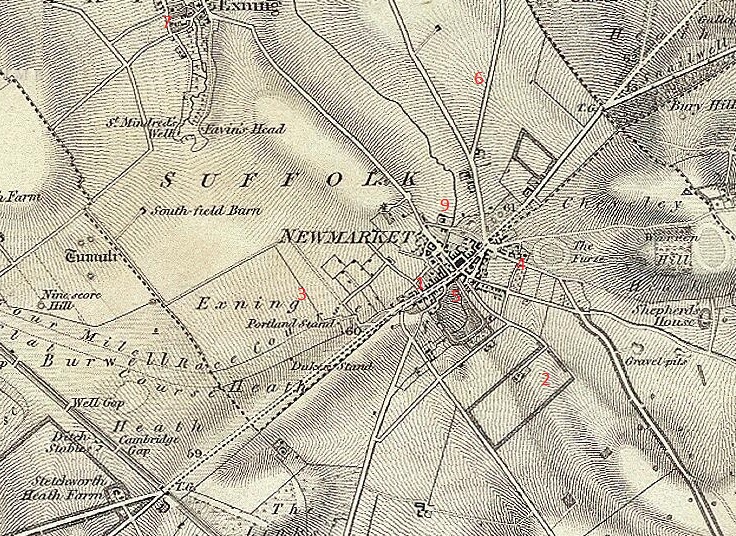
1886-1888 Henry Macksey
After the departure of Alf Sadler for Primrose House Stables, Stockbridge House was leased by Henry Macksey. Macksey had trained horses for a considerable time, both for himself and as a private trainer. In September 1886 he left Findon, where his patron was Mr Renfrew, but by February 1888 he had to move the majority of his horses from Stockbridge House to Upland Stables, Epsom after being refused a licence to train in Newmarket. He continued with a presence at Stockbridge House until July 1889 when he was warned off by the Jockey Club.
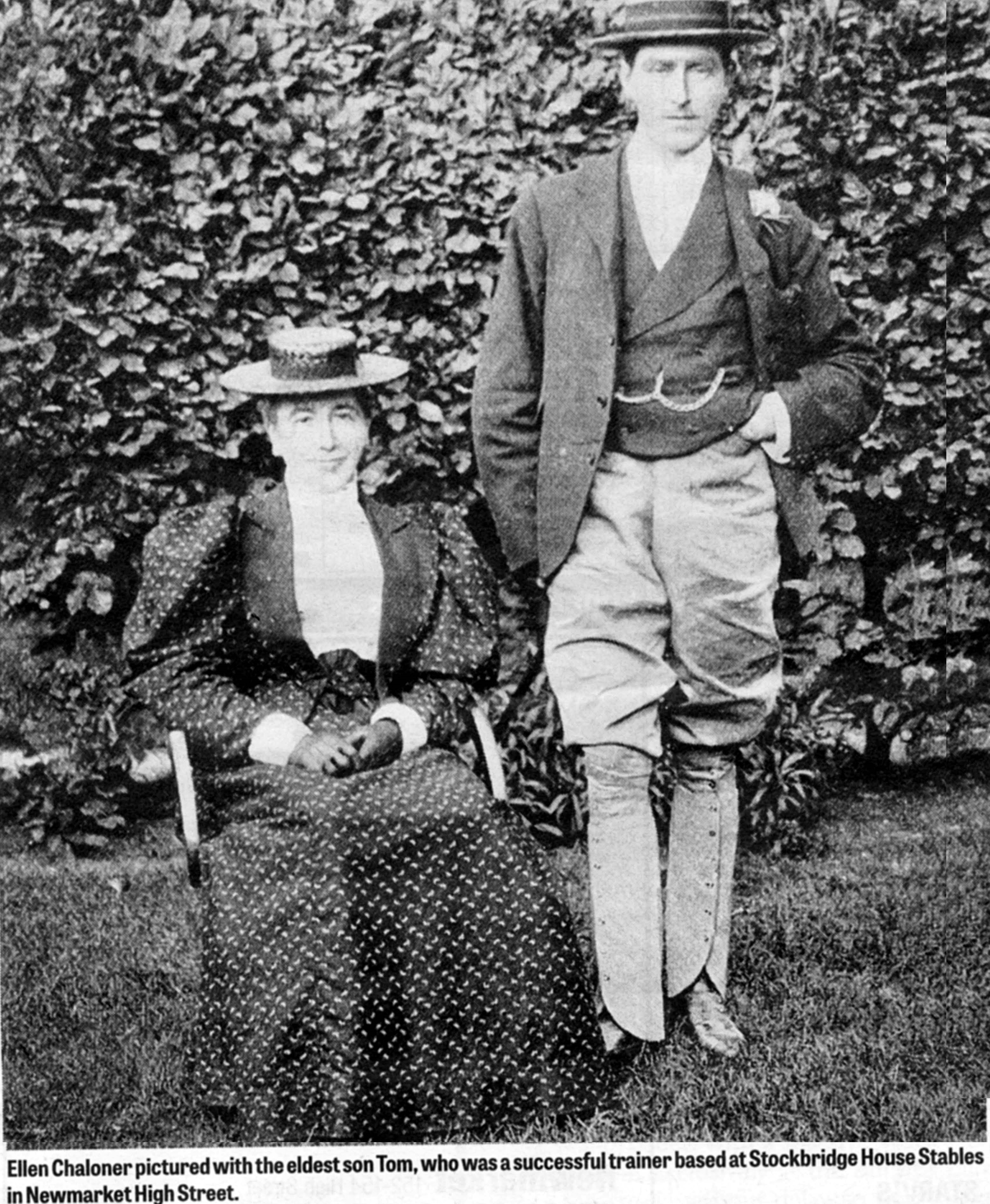
Tom O Chaloner, born in 1866, was the oldest son of Tom and Ellen Chaloner, and trained at Middleham and Newmarket. When Tom senior died at the young age of 46 in 1886 his mother Ellen, just 43 at the time and with 8 children to raise, took over at Osborne House, successfully applying for a trainer's licence, although it appears Tom junior had to be the registered trainer. Indeed, one of the controversial winners trained at Osborne House was his first winner as a trainer, Jacob, who won 2 races on consecutive days at Hampton Court racecourse in 1886. He later went on to train at Stockbridge House from 1889, training Marco to win the 1895 Cambridgeshire for owner Mr Francis Luscombe. In December 1890 a controversial incident happened at Stockbridge House when a 4-year-old horse called Bondager died of paralysis of the brain. He had just won the Trial Plate at Newmarket, after which he was sold for 500 guineas to H Gottschalk, but then died causing a dispute of ownership to be raised. In March 1896 Tom suffered a further setback when the horses of prominent owner Mr Fracis Luscombe were removed from his stables and transferred to J Cahloner's stables at Lambourn House. The string included 1895 Cambridgeshire winner Marco, as well as King's House and Lynwood. Tom moved stables to be replaced by Felix Leach. Tom died aged 72 on Monday 29th November 1937
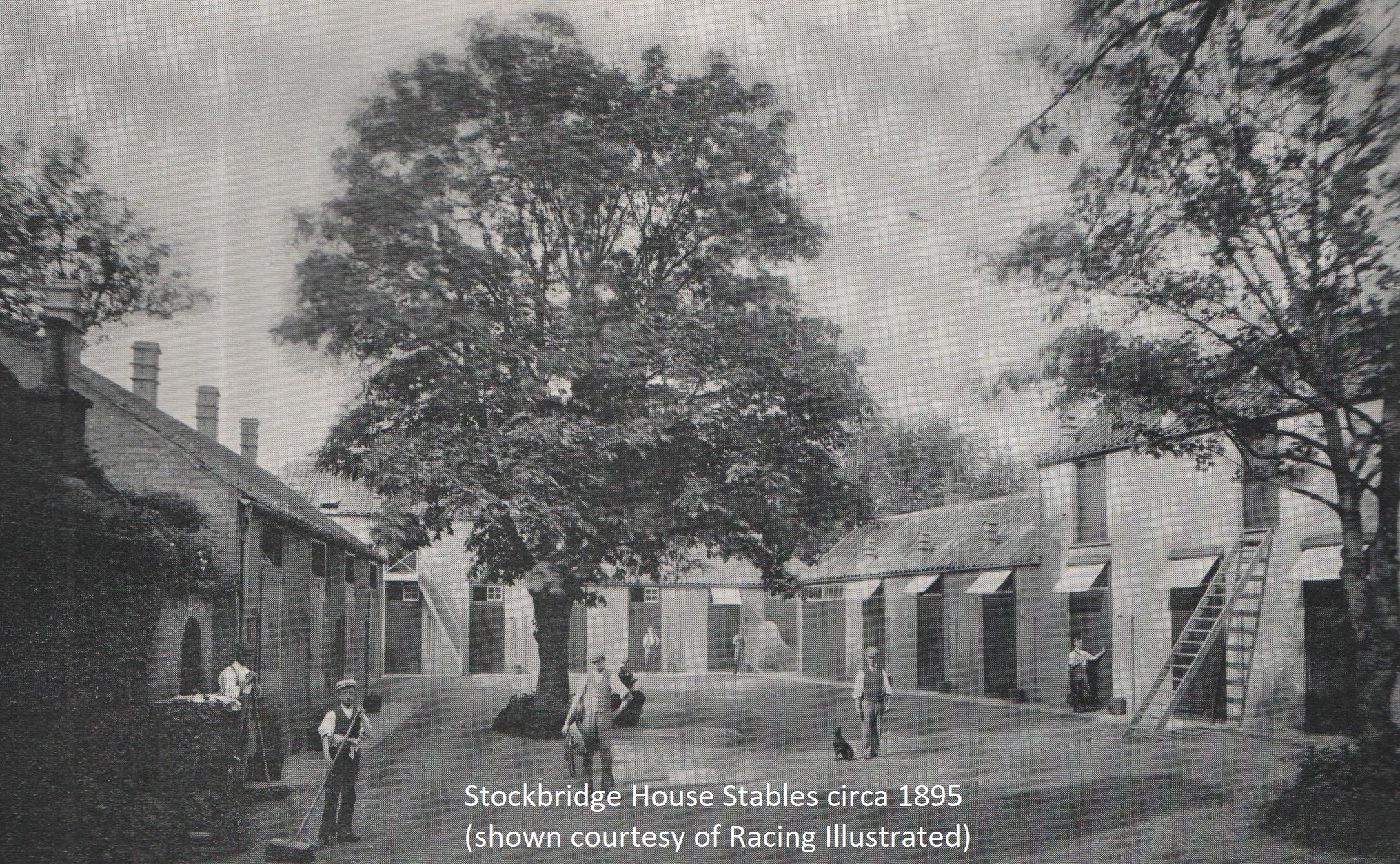
1894 Southport Stakes MARCO at Liverpool 5/1 owned by Mr F Luscombe, trained by Tom O Chaloner and ridden by Walter Bradford
1894 Fortieth Triennial Stakes at Newmarket MARCO 3/1 owned by Mr F Luscombe, trained by Tom O Chaloner and ridden by George Chaloner
1894 Chaddesden Plate QUIDNUNC 6/1 owned by Mr C A Brown, trained by Tom Chaloner and ridden by George Chaloner
1894 Kennett Plate at Newmarket MARCO 5/2 owned by Mr F Luscombe, trained by Tom O Chaloner and ridden by Tommy Loates
1895 Lewes Handicap MARCO 8/1 owned by Mr F Luscombe, trained by Tom O Chaloner and ridden by Tommy Loates
1895 Payne Stakes MARCO 6/5 fav owned by Mr F Luscombe, trained by Tom O Chaloner and ridden by George Chaloner
1895 Cambridgeshire MARCO 9/1 owned by Mr F Luscombe, trained by Tom O Chaloner and ridden by Fred Allsopp.
1895-February 1902 Felix Leach, Lord Marcus Beresford
Felix Leach, born in 1868, had a good grounding in the racing industry, acting as assistant to the legendary Mat Dawson at Heath House Stables. Legend has it that when he was 18 years old Felix Leach visited his brother in Newmarket where his brother was a vet. He was curious and inquisitive, and wandered onto the heath to view the horses. He spotted a horse which he thought stood out from the others and asked the person standing next to him what the name of the impressive horse was. The horse was St Simon and the person standing next to him was Matt Dawson. This was the beginning of a long working relationship, culminating in Felix Leach becoming a trainer after serving as assistant to Mat Dawson. In 1884 St Simon won the Ascot Gold Cup, the Goodwood Cup and Epsom Gold Cup. In 1895 Felix was given the chance to train on his own account with support from Lord Marcus Beresford at Stockbridge House Stables, replacing Tom Chaloner, and was backed by a wealthy American Mr Foxhall Keene, who had removed his horses from Beckhampton to place them with Leach. In 1902 Felix took over at Graham Place, training predominantly for Henry James King.
1900 Visitors Plate at Newmarket WILD IRISHMAN 7/4 fav owned by Henry James King, trained by Felix Leach and ridden by Tod Sloan
1900 Westmoreland Plate at Doncaster SCHOOLGIRL 7/2 owned by Henry James King, trained by Felix Leach and ridden by Johnny Reiff
1900 Flying Handicap at Newmarket ZANOONI 5/2 owned by Henry James King, trained by Felix Leach and ridden by Tod Sloan
1901 Northamptonshire Stakes EVASIT 7/2 owned by Henry James King, trained by Felix Leach and ridden by Johnny Reiff
1901 Batthvany Plate at Lincoln ESMERALDA II 3/1 owned by Henry James King, trained by Felix Leach and ridden by McIntyre
1901 Double Trial Plate at Newmarket MIMICRY 3/1 owned by Henry James King, trained by Felix Leach and ridden by Herbert Jones
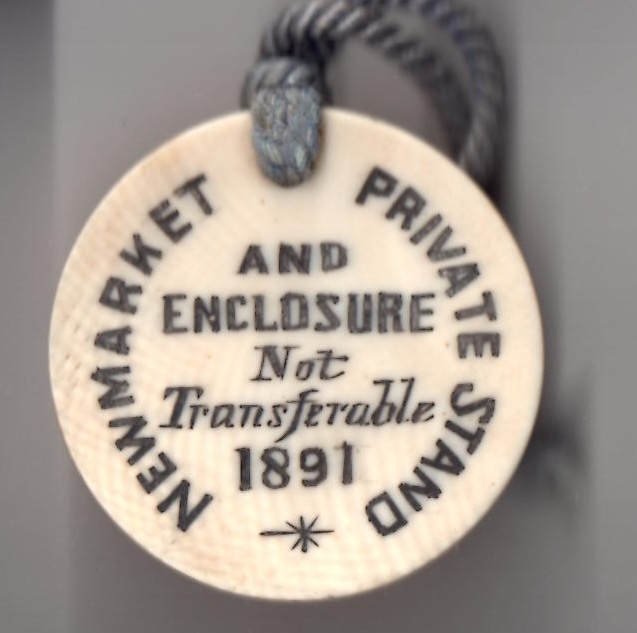
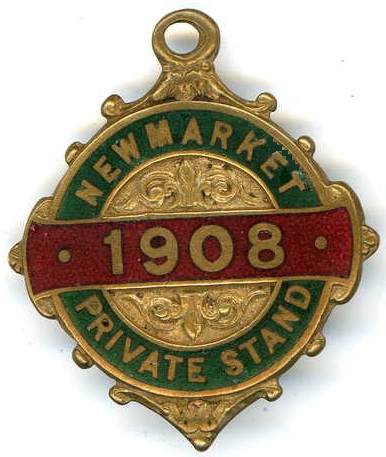
1903-29 Alf B Sadler senior
Having departed from Stockbridge House in September 1885, training at Primrose House and Graham Place, he returned to Stockbridge House in readiness for the 1903 season. Early in his second stint at Stockbridge House a happy event took place when, on Tuesday 1st December 1903, his son Alfred Day Sadler married May Lane at St Agnes Church, Newmarket. At the time his son was training at Freemason Lodge. Alf retired in 1923, but he continued to reside at Stockbridge until his death from chronic bronchitis on Thursday 24th January 1929 aged 82. In his will he left an estate with gross value £2342, equivalent to £150,000 in 2020.
There was a very lengthy period when Stockbridge House Stables was not used as a principal racing stable, although it was often used as an overflow yard by the trainer based at neighbouring Fitzroy House. That same trainer was also able to call on extra stabling at Queensbury Lodge. Frank Butters, who was based at Fitzroy House, certainly used both Stockbridge House and Queensbury Lodge as overflow stables.
Frank Butters, son of racehorse trainer Joe Butters, was born in Austria in 1878 where his father trained for a time, and Frank launched his own training career in Austria before the start of the First World War. Between 1914 and 1918 he was interned, but then moved to Italy to continue training. In 1926 he was enticed by the 17th Earl of Derby to move to England as private trainer at Stanley House, Newmarket where he enjoyed enormous success. In his 4 years at Stanley House he trained Beam (SR 1909) to win the 1927 Epsom Oaks, Toboggan (SR 1990) to win the 1928 Epsom Oaks, Fairway (SR 2125) to win the 1928 St Leger and Fair Isle (SR 1893) to win the 1930 1000 Guineas. However, as the 4 year lease came to an end, and after being crowned Champion Trainer in 1927 and 1928, Lord Derby decided that the economic climate was not right to continue in racing, leaving Frank to lease Fitzroy House and become a public trainer, training for the likes of HH Aga Khan, the 5th Earl of Durham, Prince Aly Khan, Sir Alfred Butt and Mr A W Gordon. Frank was based at Fitzroy House for almost two decades, and having already been crowned Champion Trainer when based at Stanley House, he earned a further 6 Champion Trainer titles in 1932, 1934, 1935, 1944, 1946 and 1949. He was one of the most successful trainers in the history of the turf, winning the Epsom Derby twice, the Irish Derby three times, the Epsom Oaks on 6 occasions, the Doncaster St Leger on 5 occasions, and notched single wins in the 1000 and 2000 Guineas. He claimed that his best horse was Bahram, but he had so many Classic winners to choose from. In 1949 he suffered a bicycle accident which brought to an end his training career, and he died in 1957.
Marcus Maskell Marsh, son of Classic winning trainer Richard Marsh, was born in 1904 and followed in his father's footsteps, landing his first English Classic victory with Windsor Lad (SR 2100) in the 1934 Epsom Derby when training in Lambourn, followed just 3 months later in the St Leger. He had learnt his trade from his uncle, Fred Darling, before moving on as assistant to Captain Richard Gooch at Hodcott House, West Ilsley. In 1950 he took the brave decision to transfer to Newmarket, taking charge at Fitzroy House Stables, but using Stockbridge House as an overflow yard. It paid almost immediate dividend when he was crowned British Flat Racing Champion Trainer in 1952 on the back of a dual Derby and St Leger victory by Tulyar (SR 2075). Marcus Marsh trained for over 40 years, including a final move to Somerville Lodge, before announcing his retirement in 1964, and then enjoyed 19 years of retirement during which time he wrote his autobiography, Racing with the Gods, in 1968.
John Waugh, who had previously been assistant trainer to George Colling, became private trainer to Sir Robin McAlpine at Fitzroy House, registering an early success in the Newbury Spring Cup with Pardoner. Mc Alpine joined the Jockey Club in 1961, and was the longest serving president of the Racehorse Owners Association between 1960 and 1969. In 1963 the Jockey Club purchased a set of 4 starting stalls and made them available to trainers for schooling two-year-olds. John Waugh encouraged Sir Robin to have his own set of stalls, built to the specification of Ted Wood, an expert from New Zealand. Sir Robin had realised that there were valuable, early season two-year-old races to be won in fashionable Deauville, where starting stalls were in full-time use. During the late 1950s and 1960s Sir Robin enjoyed much success, particularly with Infatuation, Marsolve (July Cup winner) and Ratification. In January 1972 Sir Robin sold Fitzroy House to Jack and David Fisher who immediately enticed Peter Robinson from Cadland Stables to train for them at Fitzroy House.
Peter John Robinson, son of a Nottingham based interior decorator, was born at Kimberley on 13th June 1936 and, after completing his statutory education became apprentice to Harry Wragg at Abington Place. He was crowned champion apprentice in 1955, riding 46 winners in that season, having secured his first winner on Prince Yaky at Birmingham racecourse on 22nd June 1952 aged 16. He was a go-to lightweight rider in Handicaps, sometimes riding as low as 7st, winning the 1955 Ebor Handicap on Hyperion Kid and the Cambridgeshire in the same year, riding Lady Zia Wernher's Retrial at 18/1. In 1957 he was aboard Retrial again in the Royal Hunt Cup which he won at 100/7 for Wernher and Cecil Boyd-Rochfort. He won the first of 3 Lincoln Handicaps in 1959 on Marshal Pil (15/2), winning again in 1964 on Mighty Gurkha (33/1), and again in 1967 on Ben Novus (22/1). In August 1969 trainer Edward (Teddy) Lambton decided to call it a day for the second time at Kremlin House Stables, leaving Peter with the decision of whether to continue to ride or to embark on a training career. He chose the latter and made an immediate success of it by landing the Cambridgeshire with Prince de Galles at 5/2 favourite, carrying only 7st 12lbs. Peter trained at Kremlin House for the final 3 months of the season, doing so well that he earned a place in the jockeys and trainer's tables. Teddy sold Kremlin House and Stables to Jeremy Hindley in time for the 1970 season, leaving Peter Robinson to lease Cadland House Stables from Arthur Goodwill, moving his string of 29 horses in readiness for the start of the 1970 season. It is clear what a good thing Prince de Galles was in the 1969 Cambridgeshire with only 7st 12lbs, for he won the race the next year carrying 9st 7lbs. In the 1971 season Peter's string had increased to 41, while in January 1972 Peter was enticed away from Cadland by Messrs Jack and David Fisher, patrons of Peter at Cadland, who purchased Fitzroy House Stables from Sir Robert McAlpine. Peter enjoyed an early success at Fitzroy House, winning the traditional start of the flat season race, the Lincoln Handicap in 1972 with Sovereign Bill. On 28th June 1978 Peter travelled back from Salisbury races with his son Philip and had a heart attack, dying aged just 42.
Frankie Durr, born in Liverpool on 10th November 1925, was a highly regarded jockey for 34 years, winning his first race at Pontefract in 1944 with Merle and his last in 1978. He served his apprenticeship at Bedford Cottage Stables, sharing the 1945 Apprentice Jockeys Title with Tommy Gosling, each notching 10 winners. He rode the winners of many top races, including no less than four English Classics, starting in 1966 when Sodium (SR 1964) won the St Leger, followed in 1973 with wins in the 2000 Guineas by Mon Fils (SR 1891), and St Leger with Peleid (SR 1914), and completing his quartet in the 1978 2000 Guineas with Roland Gardens (1890). He retired from riding in 1978 and launched his training career the next year, taking over from Peter Robinson at Fitzroy House on Black Bear Lane. He enjoyed an early success in 1979 when Ahonoora landed the King George Stakes and William Hill Sprint Championship, followed by Swelter's win in the Porland Handicap, and all seemed to be running smoothly until, in 1982, Fitzroy House Stables were hit by a virus which devastated his business. However, he bounced back with great determination in 1983, winning the Cambridgeshire with Sagamore in the hands of Taffy Thomas. In 1985 he won the Ayr Gold Cup with Camps Heath. In 1988 Alec Scott purchased Fitzroy House, although Frankie Durr was registered at Vicarage House Stables, Kirtling in 1987, continuing to train until 1991 before enjoying almost a decade of retirement, dying on Tuesday 18th January 2000 in Addenbrookes Hospital, Cambridge.
The Frenchman Claude Charlet had spells with Bill O'Gormand and Willie Musson when he moved to Newmarket in 1984, having previously spent 10 years with George Bridgeland at Lamourlaye in Paris. In 1987 he launched his own training career, training a mixed string of predominantly moderate horses at Stockbridge House once it was no longer needed as an overflow yard. He enjoyed his first winner, Bold Mojacques, in mid-September 1987 i a Huntingdon seller.
Michael Bell, son of Captain Brian Bell, was born on 10th October 1960 and began his training career at Fitzroy House in 1989. He enjoyed immediate success when his father moved Pass the Peace, the 1988 Debutante Stakes and Cheveley Park Stakes winner, from Paul Cole's stable to his sons training establishment. The horse won the 1989 Fred Darling Stakes at Newbury in the hands of Richard Quinn. Four years later Bell captured his first Classic victory when Ancestral Dancer won the Premio Regina Elena (Italian 1000 Guineas) at Cappanelle. A second foreign Classic victory was secured in 2011 when Zanzibar won the Oaks d'Italia at San Siro. However, arguably his greatest triumph to date was with Motivator (SR 2063), sewing seeds of greatness in winning the 2004 Racing Post Trophy and the 2005 Dante Stakes before coming to full fruition in the 2005 Epsom Derby. Two further Classic victories followed in 2009 when Sariska (SR 1929) captured the English and Irish Oaks. Having trained at Fitzroy House Stables for more than 30 years, there are promising signs that there is much more to come from this popular, hard-working trainer.
1994-1998 Stables remain empty
In the 4-year period between 1994 and 1998 Stockbridge Stables was empty and abandoned.
1998 Brian McMath
In 1998 Brian McMath, born on 15th July 1955, and his wife Marietta lived in the house adjacent to Stockbridge House that had once been the blacksmiths, having begun training at Cadland where he rented a few boxes. He then relinquished his licence in the early 1990s, leaving the game for 5 years, but returned in May 1996, basing himself at Chestnut Tree Stables. During his brief stay at Chestnut Tree Stables he won the 1997 Ulster Harp Derby with Docklands Limo. He later moved on to Lemberg Stables.
2016-present Denis Quinn
Denis Quinn was in love with racing from an early age, winning many point-to-point races and holding an amateur rider's licence. He gained experience at Jenny Pitman's stables, widening his experience by working at Belmont Park. He moved to England towards the end of 2013 and was successful in applying for a licence to train on the Flat and over jumps, taking up his first post in 2015 at Marlborough House Stables. He then moved to Stockbridge House Stables where he had success with Rockies Spirit on the Flat, and Stonecoldsoba and Shining Romeo over hurdles.
2017 Racing Welfare Auction Stakes at Thirsk ROCKIES SPIRIT 3/1 owned by John Mangan and Denis Quinn, trained by Denis Quin and ridden by Paul Mulrennan
2017 Hands & Heels Apprentice Handicap at Yarmouth SHINING ROMEO 10/11 fav owned by John Mangan, trained by Denis Quinn and ridden by William Cox
2017 Boxing Bed Maiden SHINING ROMEO 20/1 owned by John Mangan, trained by Denis Quinn and ridden by Jamie Moore
2017 Browns Zero Handicap Hurdle at Uttoxeter STONECOLDSOBA 11/4 owned by John Mangan, trained by Denis Quinn and ridden by Aidan Coleman
2017 Abbeyfield Whiston Court Handicap Hurdle at Worcester STONECOLDSOBA 10/1 owned by John Mangan, trained by Denis Quinn and ridden by Aidan Coleman
2018 Betyourway Handicap at Wolverhampton ROCKIES SPIRIT 4/1 owned by John Mangan and Denis Quinn, trained by Dennis Quinn and ridden by Adam Kirby
2018 1888Bet Casino Handicap Hurdle at Huntingdon STONECOLDSOBA 12/1 owned by John Mangan, trained by Denis Quinn and ridden by Aidan Coleman
2018 Smarkets Handicap Hurdle at Huntingdon SHINING ROMEO 13/2 owned by John Mangan, trained by Denis Quinn and ridden by Aidan Coleman
2018 Smarkets.com Handicap Hurdle at Huntingdon SHINING ROMEO 6/1 owned by John Mangan, trained by Denis Quinn and ridden by Aidan Coleman
2019 Mansionbet Handicap Hurdle at Huntingdon STONECOLDSOBA 15/2 owned by John Mangan, trained by Denis Quinn and ridden by James Bowen



